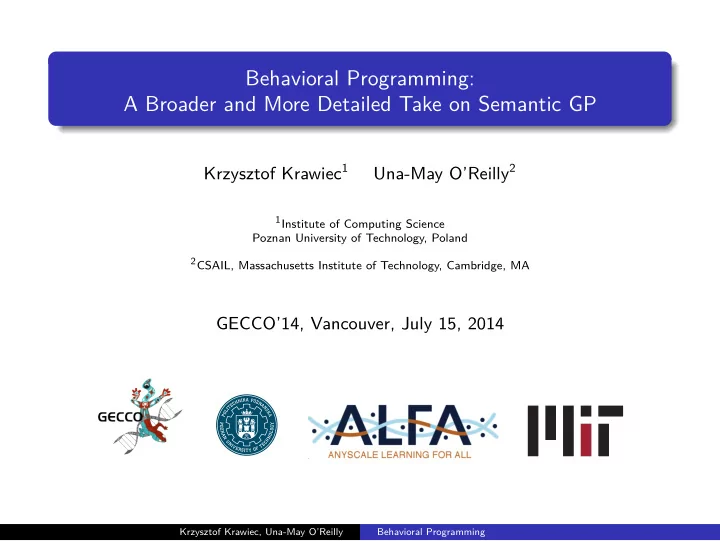

Behavioral Programming: A Broader and More Detailed Take on Semantic GP Krzysztof Krawiec 1 Una-May O’Reilly 2 1 Institute of Computing Science Poznan University of Technology, Poland 2 CSAIL, Massachusetts Institute of Technology, Cambridge, MA GECCO’14, Vancouver, July 15, 2014 Krzysztof Krawiec, Una-May O’Reilly Behavioral Programming
Problem statement and key insights Problem: Evaluation bottleneck in Genetic Programming 1 Hypothesis: Richer evaluation feedback can make search more efficient 2 Proposed solution: Behavioral programming 3 Result: Better performance and implicit problem decomposition 4 Krzysztof Krawiec, Una-May O’Reilly Behavioral Programming
Conventional evaluation in GP GP = iterative search in program space, driven by fitness function program Search algorithm Fitness function fitness Complex evaluation process Yet: scant feedback for the search algorithm (scalar fitness) Krzysztof Krawiec, Una-May O’Reilly Behavioral Programming
Semantic-aware evaluation program Search algorithm Fitness function semantics Richer feedback: semantics (program output for every example) Specialized search operators exploit program semantics E.g., using the geometric properties of semantic space (Moraglio et al. 2011) Krzysztof Krawiec, Una-May O’Reilly Behavioral Programming
Observations Semantics does not capture the entirety of program activity. Only the output of a program matters. Program output is a combined effects of multiple execution steps (instructions). A program can produce incorrect output, even if it is partially correct, i.e., features subprograms that produce useful/correct partial results. Krzysztof Krawiec, Una-May O’Reilly Behavioral Programming
Example: Calculating the median Input: list Sort(list) Central(list) Output: median(list) The sorted list is a desired intermediate computation state . Stage-wise problem decomposition. Krzysztof Krawiec, Una-May O’Reilly Behavioral Programming
PANGEA: Pattern-Guided Evolutionary Algorithm Actual Program Desired program input output output Program execution p ( x ) - x y f Program error Krzysztof Krawiec, Una-May O’Reilly Behavioral Programming
PANGEA: Pattern-Guided Evolutionary Algorithm Actual Desired Program program output input output Program execution p ( x ) - y x f Program error Program s 1 ( x ) s 2 ( x ) ... trace Classifier error e Training set ML classifier Classifier complexity c (size) Black: Conventional GP Green: PANGEA (Krawiec & Swan, GECCO’13) Krzysztof Krawiec, Una-May O’Reilly Behavioral Programming
Example (nominal domain, tree-based GP) Problem ML dataset Decision tree x 1 x 2 y x 1 x 2 x 3 x 4 y GP Individual x 4 2 3 3 2 3 4 5 3 = 1 6 = 1 1 0 2 1 0 1 1 2 - 3 1 4 3 1 9 4 4 y = 2 0 1 2 0 1 0 1 2 x 1 -1 = 2 6 = 2 0 * + 5 y = 3 y = 4 -1 4 5 x 1 x 2 x 1 x 1 1 1 9 4 Evaluation: 2 2 3 2 0 1 1 1 0 1 Program error 10 3 3 1 3 Classifier error 0 examples 0 0 1 0 Classifier complexity 5 nodes Krzysztof Krawiec, Una-May O’Reilly Behavioral Programming
Behavioral programming Behavioral programming = PANGEA extended with: Multiobjective evaluation and selection (NSGA-II, Deb et al . 2002), Archiving of promising subprograms, Mutation operator supplied by subprograms from the archive. Population Fitness evaluation Mutation Archive- Archive of based subprograms Objective1: Objective2 mutation Objective2 program Crossover Objective2 error Selection Krzysztof Krawiec, Una-May O’Reilly Behavioral Programming
Experiment: Benchmarks Domain Instruction set Problem Variables Fitness cases Space size 2 64 Cmp6 6 64 2 256 Cmp8 8 256 2 64 and, Maj6 6 64 2 256 nand, Maj8 8 256 Boolean 2 64 or, Mux6 6 64 2 2048 nor Mux11 11 2 , 048 2 64 Par6 6 64 2 256 Par8 8 256 3 27 a i ( x , y ) D-a1..a5 3 27 Categorical 3 15 a i ( x , y ) M-a1..a5 3 15 Keij1,Keij4 1 Nguy3,Nguy4 1 +, − , Nguy5,Nguy6 1 ∗ , %, Nguy7,Sext 1 sin, cos, Keij5, Keij11 2 Regression 20 – log, exp, Keij12, Keij13 2 − x Keij14, Nguy9 2 Nguy10, Nguy12 2 Keij15 3 Krzysztof Krawiec, Una-May O’Reilly Behavioral Programming
Experiment: Configurations GP Behavioral programming GP1 GP1L GP2 BPGP4 BP2A BPGP4A Program error ✓ ✓ ✓ ✓ ✓ ✓ Program size ✓ ✓ ✓ ✓ Objectives Classifier complexity ✓ ✓ Classifier error ✓ ✓ Mutation 0.1 0.1 0.1 0.1 0.1 0.1 Operators Crossover 0.9 0.9 0.9 0.9 Archive mutation 0.9 0.9 Pop. size 100 1000 100 100 100 100 Decision tree: REPTree (fast, applicable to classification and regression) Statistics: Friedman test + Shaffer’s post-hoc analysis Krzysztof Krawiec, Una-May O’Reilly Behavioral Programming
Experiment: Results (Ranks averaged over 35 benchmarks) Success rate: BPGP4A GP1L BP2A BPGP4 GP1 GP2 2.43 3.10 3.36 3.43 3.86 4.83 Program error: BPGP4A GP1L BP2A BPGP4 GP1 GP2 2.17 2.21 3.31 3.71 3.79 5.8 Predictive accuracy: BPGP4 BPGP4A BP2A GP1 GP1L GP2 2.65 3.35 3.47 3.47 3.59 4.47 Run time: GP1 GP2 BPGP4 BPGP4A BP2A GP1L 1.09 3.11 3.77 3.97 4.09 4.97 Program size: GP2 BPGP4 BP2A GP1 GP1L BPGP4A 1.26 2.57 2.89 3.91 4.81 5.56 Essential factors: behavioral evaluation and archive-based mutation Krzysztof Krawiec, Una-May O’Reilly Behavioral Programming
Conclusions Behavioral programming = Better-informed search process Better search performance Almost parameterless Domain-independence Implicit problem decomposition Applicable to all GP paradigms Future/ongoing work: Alternative ‘pattern detectors’ (PPSN’14) Acknowledgment: Krzysztof Krawiec, Una-May O’Reilly Behavioral Programming
Recommend
More recommend